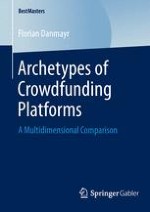2014 | Buch
Über dieses Buch
Currently, a new potential paragon of fundraising and financing, in particular crowd funding (CF) attracts a lot of attention. Basically, CF is an open call for capital, mainly via the internet, where the desired campaign can be evaluated and financially supported by a large group of individuals, the crowd. The matchmaking process between campaign creators and potential investors is mainly established by a standardized CF platform (CFP). Scientific discourse on CF is still nascent, since existing studies and papers focus on the potential of CF and its basic principles. Florian Danmayr addresses crowd funding platforms as object of his analysis and contributes to the body of literature by enhancing knowledge on the composition of the CFP market.
Anzeige
